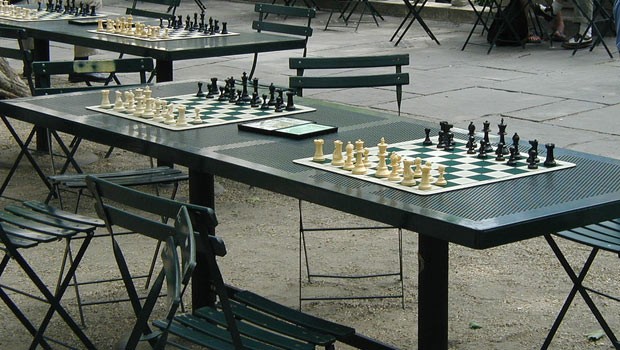Here, I will describe a new type of chess puzzle, which I call Scrambled Chess. This is going to be a small example puzzle; I will commence a larger series (Scrambled Sundays!) which will feature full puzzles posted biweekly. (The first one will be posted tomorrow, Dec 2nd!)
Image from http://sp.life123.com/bm.pix/scrambled-eggs1---eggs-on-plate.s600x600.jpg
Like Freeze Chess and ChessWords, I think Scrambled Chess is a good tool for visualization. In fact, they are probably even better, since they can test visualization skills in several different ways. Also, unlike Freeze Chess (which I developed independently, but are very similar to Bruce Alberston's Chess Mazes), it seems that Scrambled Chess is completely novel. They are also somewhat difficult to explain, but hopefully the example below will make the objective and rules clear.
As an introduction, here is a smaller version of one of these puzzles. (The rules / how to play is described below).
Introduction / Example Puzzle. Movement is Rook by Knight (The notation used for these puzzles will be RxN). Starting Square: A4. Target Square: B1
This is a smaller, 4x4 board (the real puzzle would be a standard 8x8 board). As you can notice, each square is inscribed with the coordinates of another square. The goal is to make piece movements that are legal for both, according to the pieces specified.
In these puzzles, two pieces will be specified, from the choice of Knight, Bishop or Rook. The first piece dictates the movements that should be taken on the board, while these movements must correspond to legal moves in within the scrambled coordinates.
If the puzzle is Rook by Knight (This one is, as specified by RxN), this means that only Rook moves are allowed, but the correct moves are those to squares with written coordinates that correspond to a Knight move.
The goal is to go from the starting square (shown in brick red) to the target square (shown in blue), making moves that conform to the above rules.
As mentioned above, I will be posting a puzzle every other week, on Sunday (starting tomorrow). Some of these puzzles can be complex, and can be any combination of Rook, Knight, or Bishop moves (RxR, RxN, NxN, NxB, etc). Remember, the first piece dictates movement on the puzzle board, the second piece corresponds to the coordinates inscribed within each square. In this same notation, I have developed puzzles such as Rx2N; what this signifies is that the moves must be with coordinates that correspond to a two move hop of the Knight.
In the above example, a Rx2N move would be A4-A3, since this uses the inscribed coordinates E4-D5. This corresponds to a two move route of the Knight; E4-f6-D5, or E4-c3-D5. In this particular example, however, that would be a dead end (you cannot read the target square under those conditions).
What do you think of Scrambled Chess? Please share your thoughts by leaving a comment below!
Please hit 'Read More' for the solution to the above puzzle, explained. For now, I've suddenly got an appetite for some scrambled eggs....

















